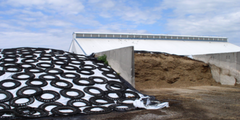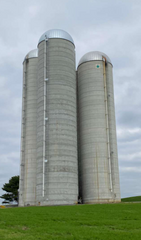Unit 7: Common Feeds For Livestock (Cram)
1/65
There's no tags or description
Looks like no tags are added yet.
Name | Mastery | Learn | Test | Matching | Spaced |
|---|
No study sessions yet.
66 Terms
What are the three categories of livestock feed?
Forages
Energy supplements
Protein supplements
What part of green plants is used for forages?
Above ground
Forages generally contain more than ___ % crude fiber
18
What substance in forages makes them have decreased digestibility?
Lignin
Which two macro minerals are forages high in?
Calcium
Potassium
True or false: Forages are generally higher in trace minerals than most concentrates
True
Do forages have more or less fat–soluble vitamins than most concentrates?
More
Which water soluble vitamin are forages generally high in?
B–vitamins
In general, total fiber content of a plant with age, this ______ its feeding quality for livestock
decreases
The quantity of forage produced (yield) _____ with time
increases
What type of carbohydrate are younger plants high in? Give an example
Digestible, like starch
What types of carbohydrates are older plants high in? Give two examples
Less digestible, like cellulose and lignin
Area of land on which there is growth of forage suitable for animals to graze
Pasture
What are some of the benefits of putting animals on pasture?
Decreased likelihood of nutritional deficiencies, less disease transmission (not in close confinement), lower costs for facilities, animals get exercised (not as over–conditioned)
Grass used for pasture that will grow back in subsequent years
Perennial
Grass used for pasture that must be seeded every year
Annual
What group of pasture forages include clover and alfalfa, and are generally higher in protein, vitamins, and some minerals than most grass species?
Legumes
What do legumes use to convert atmospheric nitrogen to a form of nitrogen the plant can then use to grow? What is this process called?
Bacteria living in their roots, nitrogen fixation
Term for forage that is cut, cured (dried), gathered, and utilized for feed
Hay
What is the ideal range of moisture content for hay that preserves its nutritional value?
15–18%
What can happen if hay has a moisture content of over 20%?
Mold or fire
What is the most important determinant of the nutritional value of hay?
Stage of maturity when it is harvested (more mature = less digestible)
What is the range of loss of yield that is normal for hay?
20–40%
Where does hay suffer more nutritional losses, inside or outside?
Outside, 30–35% from UV damage
What are some grass hays?
Timothy, orchard grass, tall fescue, smooth brome grass, and green barley and oats
How is the quality of legume hays usually determined?
Amount of leaf in the hay
What are two type of crops that have been harvested and stored at moisture levels higher than 20% and are preserved through microbial fermentation in anaerobic conditions?
Silage
Haylage
What is the range of moisture content for silage?
70-75%
What is the range of moisture content for haylage?
50-60%
What bacterial genus commonly grows in silage?
Listeria
Which is easier to produce in areas that experience heavy rainfall, hay or silage?
Silage
What kind of crops is silage made from? Give some examples
Cereal grains, like corn, barley, or oats
What kind of crops is haylage made from? Give some examples
Forages, like grasses and legumes
Which is allowed to dry in the feild before being stored, silage or haylage?
Haylage
Storage facility used to provide an anaerobic environment in which the fermentation of the silage or haylage can take place
Silo

What type of silo is this?
Bunker silo (also called pit or trench silo)

What kind of silo is this?
Tower Silo

What type of silo is this?
Temporary silo (also called bagged silage)
Why should silage not be fed to horses?
High risk of botulism which horses are very susceptible to
What are some advantages of using silage?
Reduced losses of nutrients (leaves falling off), not weather dependent, less fire hazard, less internal parasites
What are some of the disadvantages of using silage?
More labour intensive, special equipment needed, too heavy to transport, experience is required
What are the three factors that have the greatest influence on the energy value of a feed?
Starch content
Fiber content
Fat content
What are the two energy supplements most commonly used?
Cereals
Fats
What amino acid are most cereal grains deficient in?
Lysine
Cereal grains have about 10% protein, is this protein availible to all species of livestock?
No. It is not of a sufficient quality for non–ruminant livestock (ie. horses)
What are the five cereal grains commonly used in animal feeding? Remember: Barley Regulates COW (because it has a high fiber content)
Barley
Rye
Corn
Oats
Wheat
Which cereal grain is the one most commonly fed to livestock worldwide?
Corn
Of the cereal grains, corn is the lowest in _____
protein
Why is wheat not fed to poultry?
It contains alot of the NSP hemicellulose, this turns into a thick gel when combined with watery. It thus results in sticky droppings
What is the most commonly fed cereal grain in Canada?
Barley
Because of the fibrous hull that clings tightly to barley, the _____ content is higher and the _____ value is lower than that of corn or wheat
fiber, energy
Which cereal grain is the most popular for feeding horses, because the high fiber content reduces the risk of colic?
Oats
Despite the low quantity (less than 10%), oats have the highest quality _____ of any cereal grain
protein
What are the three fat based energy supplements?
Peas
Molasses
Fat
Which amino acid are peas deficient in?
Methionine
How many times more protein do peas have compared to most cereal grains?
2 times (23%)
Fat has ____ times the energy content of any cereal grain
2.25
What are the two main groups of protein supplement sources?
Plant sources
Animal sources
What are the three plant sources of protein?
Soybean meal
Canola meal
Linseed meal
What is the protein content of hulled and dehulled soybean meal respectively?
Hulled: 44% Dehulled: 49%
What is the range of protein content of canola meal?
35-40%
Canola meal has less lysine and higher levels of methionine. This makes it a good supplement for which diet?
Pea diet. Because peas are deficient in methionine
What is the protein content of linseed (flaxseed) oil?
35%
What does flax contain that has human health benefits when hens deposit it in their eggs?
Omega-3 fatty acids
The transmission of which disease is the reason why it is illegal to feed meat meal from a ruminant back to a ruminant?
Mad Cow disease
What are some of the commonly used sources of animal protein?
Meat meal, blood meal, fish meal, and dehydrated milk products